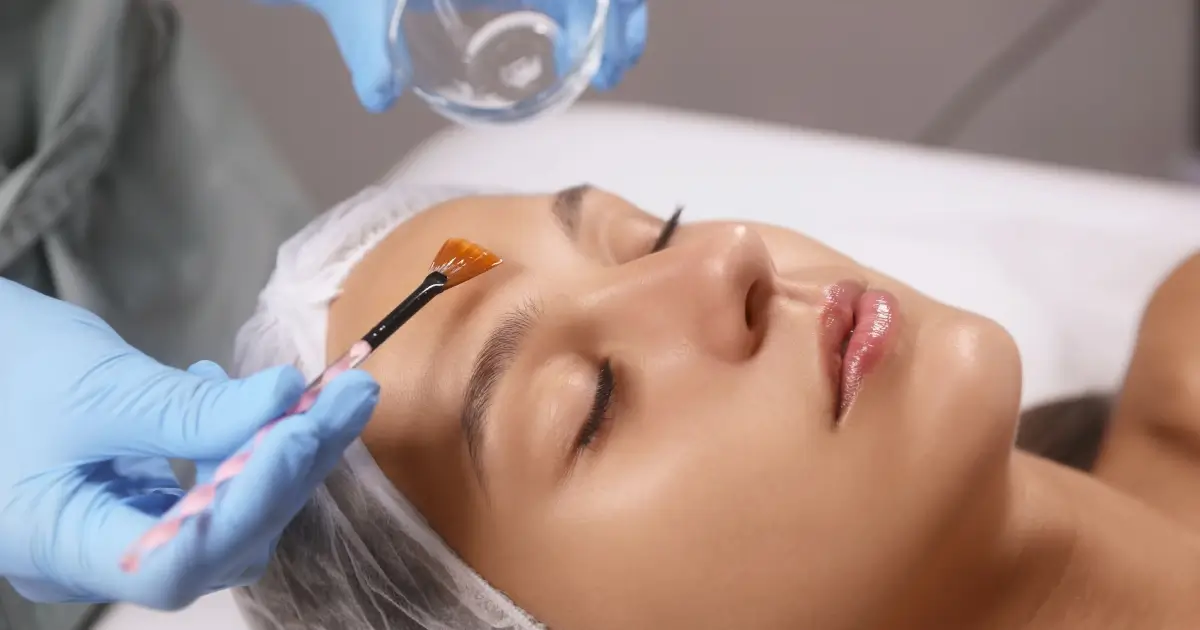- What Exactly Is Melasma?
- Do Chemical Peels Work for Melasma?
- How to Treat Melasma with Chemical Peels
Melasma is one of those skin concerns that shows up uninvited and sticks around longer than most of us would like. Characterized by patchy, brown or grayish areas, usually on the cheeks, forehead, or upper lip, it can feel frustratingly persistent.
There’s a reason skincare professionals often recommend chemical peels as one of the best treatments for melasma. If you’ve been exploring melasma treatment options, this one deserves a closer look. Whether you’ve been battling melasma for years or just noticed new pigmentation showing up, understanding how chemical peels work is the first step toward brighter, clearer skin.
What Exactly Is Melasma?
The pigment that gives your skin its color, melanin, is overproduced in melasma, a type of hyperpigmentation. The most frequent causes of it are:
- Sun exposure
- Hormonal changes (like pregnancy or birth control)
- Genetics
- Certain medications
While it’s not harmful, melasma can be hard to treat with just topical skincare. It lives deeper in the skin compared to surface-level pigmentation, which means you often need more than creams and SPF to get real results.
Do Chemical Peels Work for Melasma?
Chemical peels are a skin-resurfacing treatment that uses gentle acids to exfoliate the outer layers of skin. This process removes dull, damaged cells and encourages fresh, healthier cells to surface. When it comes to melasma, this shedding process can help lighten dark patches over time by targeting the discolored skin and improving overall tone and texture.
Peels also promote collagen production, even out the skin, and improve how well other skincare products work by allowing them to penetrate more deeply.
Every chemical peel at Gentle Giant Care in Atlanta, GA, is tailored to your skin type, sensitivity, and objectives. That means we’ll find the best peel for melasma with the right strength and formula to fade your melasma safely and effectively.
How to Treat Melasma with Chemical Peels
Melasma isn’t a condition that clears up overnight, and that’s why consistency matters. For many people, the best approach involves a series of peels spaced several weeks apart. Here’s how that plays out:
1. Start with a Professional Evaluation
Not everyone experiences melasma in the same way. It might be dermal, meaning it penetrates deeper, or superficial, meaning it sits closer to the skin’s surface. To decide which peel will work best, we always start with a skin evaluation.
At Gentle Giant Care, we take your full skin history into account, including previous treatments, sun habits, and sensitivity, to make sure your skin stays healthy during treatment.
2. Choose the Right Peel for Your Skin
Not all peels are created equal, especially when treating something as tricky as melasma. Some peels are too aggressive and can actually make pigmentation worse if not chosen carefully. That’s why we offer options like:
Jessner Peel
This formula combines lactic acid, salicylic acid, and resorcinol to lift pigmentation and break up dark patches. It’s especially helpful for melasma hyperpigmentation and acne scars, making it a strong contender if your discoloration is more than sun-related.
Level 1+ Peel
This treatment blends L-ascorbic acid and salicylic acid to address both pigmentation and signs of aging. It’s a strong yet manageable option for those who want visible improvement after just one session.
Level 2 Peel Series of Four
This peel goes deeper and works best when performed in a series. The focus here is on stubborn pigmentation and scarring, so it’s ideal for more advanced or dermal melasma cases. Throughout four treatments, you’ll see gradual lightening and smoother skin texture.
What to Expect During and After a Chemical Peel
Getting a chemical peel for melasma is a fairly quick process, usually around 30 to 45 minutes. You might feel some tingling or warmth during the treatment, but it’s generally very tolerable.
Afterward, your skin may look slightly pink or feel tight, and you’ll experience some light peeling over the next several days. Don’t worry, this is all part of the exfoliation process. The important thing is to follow post-care instructions closely and avoid sun exposure, which can undo all the progress you’re making.
We always recommend wearing broad-spectrum SPF every single day after your peel, no exceptions. Sun protection is key when treating melasma since UV exposure is one of its main triggers.
Who Is a Good Candidate for Chemical Peels?
Chemical Peels in Atlanta, GA, can be a great fit for many people, but they’re not for everyone. If you’re pregnant, have open wounds, or are currently using certain acne medications, you may need to wait before starting peel treatments.
Skin tone is another factor. While many peels are safe for darker skin tones, the type of acid and its strength need to be carefully chosen to avoid unwanted side effects like post-inflammatory hyperpigmentation. That’s why a customized approach is so important.
If you’ve tried other melasma treatments with limited success, a professionally guided chemical peel might be the missing piece. We’ll walk you through every step and adjust as needed along the way.
How Many Peels Do You Need to See Results?
The degree of your melasma, the kind of peel being applied, and how your skin reacts will all affect this. Some people notice brighter skin and less pigmentation after just one session, but most will need a series of treatments to see full improvement.
Generally speaking, you can expect:
- Light melasma or surface pigmentation: 2 to 3 treatments may be enough.
- Moderate melasma: Plan for 4 to 6 peels spaced about 3 to 4 weeks apart.
- Deep or stubborn melasma: A series of 6+ peels, potentially combined with topical treatments or in-office maintenance sessions.
Remember, it’s a gradual process, but one that’s worth it when you start seeing those dark patches fade.
How to Maintain Your Results
Once you start seeing progress, it’s tempting to ease up on the aftercare—but don’t! Melasma has a sneaky way of returning if you let your guard down. To keep your skin clear:
- Use sunscreen every single day, even when it’s cloudy
- Stick with your home skincare plan between peels
- Avoid tanning beds or prolonged sun exposure
- Schedule maintenance peels or check-ins as recommended
Consistency is everything. With the right habits and follow-up care, your results can last much longer and keep melasma from returning.
Melasma Doesn’t Have to Be Permanent
Living with melasma can feel discouraging, but it’s not something you have to accept forever. Chemical peels offer a reliable, results-driven option to lighten discoloration and even out your skin tone, especially when they’re part of a thoughtful, customized plan.
If you’re in the Atlanta area and curious about whether peels are right for your skin, let’s talk. At Gentle Giant Care, your skin’s story is personal to us, and we’re ready to help you write a brighter next chapter. Ready to fade melasma and reveal brighter skin? Book your consultation today!





